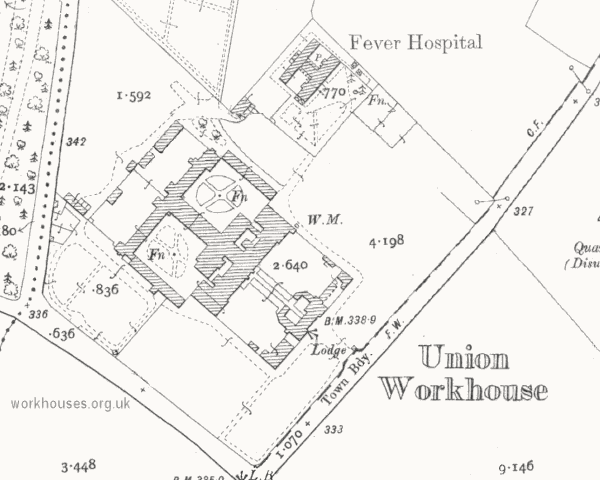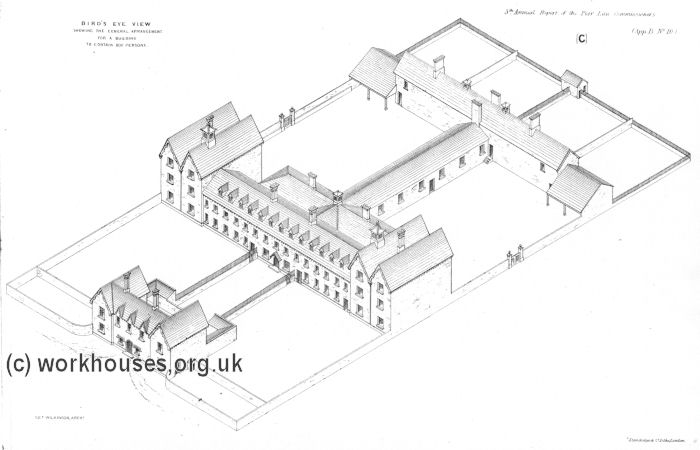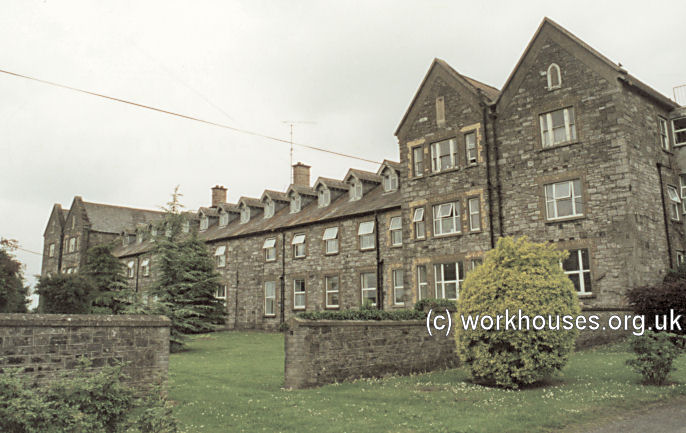County Home, Mullingar, Co. Westmeath, Republic of Ireland
The Mullingar County Home had its roots in the Mullingar Union Workhouse, erected in 1840-42 on a seven-acre site on Castlepollard Road, half a mile to the north of Mullingar. Like almost all Irish workhouses, the original buildings were designed by George Wilkinson. There was a small entrance block, nearest to the road. The main accommodation block had the Master and Matron's's quarters at the centre, with male and female wings to each side. A single-storey range containing the kitchen and laundry then linked via the dining-hall and chapel to the infirmary and 'idiots wards' at the rear of the complex. The buildings were intended to accommodate up to 800 inmates. During the famine era, a fever hospital was erected at the north of the site.
The Mullingar workhouse site is shown on the 1914 map below.

Mullingar workhouse site, Mullingar, c.1914.

George Wilkinson's model Irish workhouse design. © Peter Higginbotham

Former Mullingar workhouse main building, 2000. © Peter Higginbotham
From 1899, the Sisters of Mercy provided the nursing staff in the workhouse infirmary.
Following the creation of the Irish Free State in 1921, the Boards of Guardians that had administered each union area were abolished and the government appointed commissioners to overhaul the existing poor relief system and formulate a county-based plan for its future administration and operation. Boards of Public Assistance and Boards of Health were formed in each county and the existing workhouse sites allocated to new roles. In most cases, the main building in one of the county's former workhouses was adopted as a County Home, accommodating the elderly poor and infirm, the disabled, and people with various mental conditions, referred to at that time as 'lunatics', 'idiots' and 'imbeciles'. County Homes were frequently also used to house unmarried mothers and their children, and some admitted orphaned or abandoned children. Many former workhouse infirmaries, fever hospitals and other medical facilities were redesignated as County, District, Cottage or Fever Hospitals. The county schemes were formalised by Local Government (Temporary Provisions) Act of 1923. In County Westmeath, the main building of the Mullingar workhouse was used as a County Home, the workhouse infirmary as a County Hospital.
A report on the Westmeath County Scheme in 1927 noted:
The County Hospital consists of the infirmary portion of the workhouse, It is well equipped and has a good operating theatre and good sanitary and bathing accommodation. A maternity department for respectable women is administered in connection with the hospital.
Although the County Home and the County Hospital are managed as separate institutions, the fact that they are both in the old workhouse must make it difficult to disassociate them in the public mind.
The County Fever Hospital is a detached building in the grounds of the County Home. The ground floor wards, by reason of the want of other accommodation, are used for cases of tuberculosis. This is not an arrangement that should be continued.
In August 1929, a meeting of the county Board of Health discussed a letter form the Department of Local Government and Public Health. It requested the Board to deal carefully with each unmarried mother coming into its care, with a view to ascertaining if any of them would be likely to make an effort towards supporting herself if given an opportunity of taking up employment outside. The Board decided to ask the home's Chaplain to consult with the parish priest of the district where the girls came from.
In 1951, the county councils of Meath, Westmeath, Cavan, Longford, and Louth formed a consortium to open a new mother and baby home, which opened at Dunboyne in 1955. The Mullingar County Home then stopped being used for this purpose.
The County Home and Hospital site subsequently adopted the name St Mary's Hospital, now known as St Mary's Care Centre. The old infirmary block was demolished in 2000. Most of the other old buildings continue in use alongside newer accommodation.
Records
Note: many repositories impose a closure period of up to 100 years for records identifying individuals. Before travelling a long distance, always check that the records you want to consult will be available.
- Westmeath County Library HQ, Dublin Road, Mullingar. Many records have restricted access. Please contact the Archives department before visiting to discuss your query. Information on holdings relating to the County Home is currently unavailable. Workhouse records include the Board of Guardians' minute books (1857-1921) .
Bibliography
- Nicolson, Jill Mother and Baby Homes: a survey of homes for unmarried mothers (1968, Allen & Unwin)
- Redmond, Paul Jude he Adoption Machine: The Dark History of Ireland's Mother and Baby Homes and the Inside Story of How Tuam 800 Became a Global Scandal
Links
Except where indicated, this page () © Peter Higginbotham. Contents may not be reproduced without permission.


